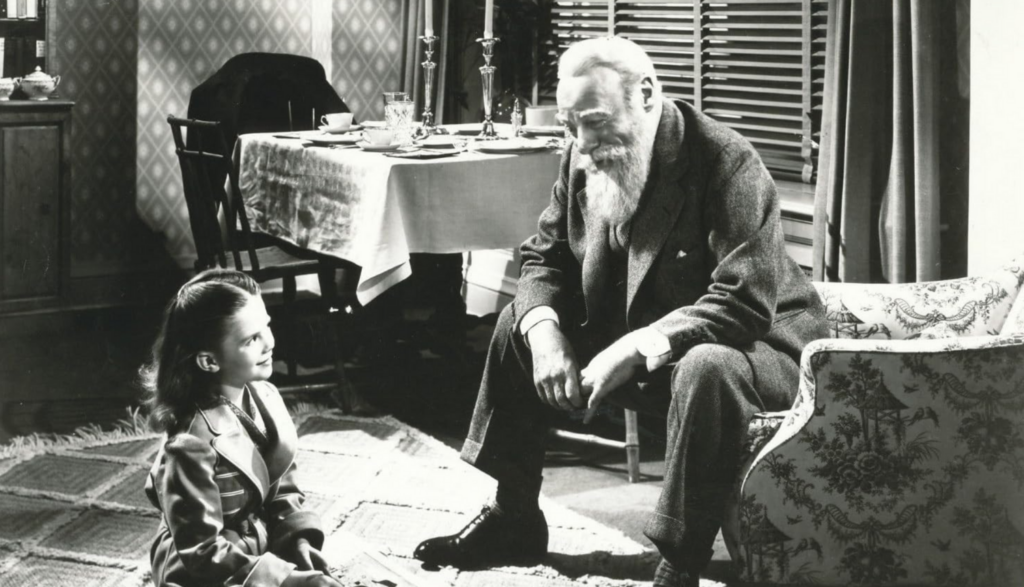
Just call him Kringle. Kris Kringle.
He’s a man of mystery, he is. He came from nowhere—showing up at Macy’s Thanksgiving Day Parade just as it was about to begin. But parade organizer Doris Walker took one look at him, and she could see this fellow knew his way around a sleigh, one who liked his eggnog shaken, not stirred.
Almost immediately, Doris presses him into her Macy’s secret service. The parade’s star—the man originally hired to impersonate Santa Claus at its end—has consumed enough booze to make him a right tipsy old elf, and Macy’s insists that its Santas be sober. Clearly, another must be found. Doris looks at the stranger and notes his twinkling eyes. His merry dimples. How the beard on his chin is as white as the snow.
“You could be Santa Claus!” Doris says. “Have you had any experience?”
“Oh a little,” the man says with a chuckle.
Kris, naturally, charms the living daylights out of parade-goers. He’s promptly given a license to fill Santa’s plush seat in New York’s most glamorous department store, welcoming the city’s bevy of boys and girls to climb up on his lap and tell him what they want for Christmas. Oh, and encouraging their parents to spend as much money as possible too, of course.
The store’s execs know they’ve found a man with the golden touch, and they expect their new Santa to push Macy’s toys from here ‘til the sky falls.
But Kris has his own idea about how a Santa should behave. If Macy’s doesn’t have something that toy-buyers want, he points them to stores that do. The higher-ups aren’t pleased at all—until they start hearing the praise from Macy’s flabbergasted customers.
“Putting the spirit of Christmas ahead of the commercial! It’s wonderful!” one mother says, adding that she’s going to be a loyal Macy’s customer from now on.
Yes, this Christmas season is indeed proving to be a particularly wonderful one. It’s wonderful for Macy’s. It’s wonderful for its customers. It’s even wonderful for Mr. Kringle, who loves to see people enjoy this most wonderful time of the year.
But Doris begins to wonder about all this wonderfulness. She, and a handful of others, begin to ask, “Just who is this Mr. Kringle?”
His personnel file is of little help. It lists his birthplace as “North Pole.” His date of birth as, “As old as my tongue and a little bit older than my teeth.” His next of kin? “Dasher, Dancer, Prancer, Vixen, Comet, Cupid, Donder, Blitzen.”
Could it be that this man of mystery is one of 1947’s most committed method actors? Or could the guy be a few sugarplums short of a Christmas feast? Because there’s no way the guy could actually be—well, you know, The Guy. Right?
Whether he’s really Mr. Claus or merely cracked, there’s one thing that everyone (well, nearly everyone) can agree about: He’s just about the nicest, kindest old gentleman you’d ever hope to meet.
Not that Kris doesn’t have standards. When he comes across Macy’s drunk parade Santa, Kris is furious. “You’re a disgrace to the tradition of Christmas!” he says. And when an amateur psychologist alleges that another would-be Santa only wants to be Santa because of underlying psychological issues, Mr. Kringle takes him to task.
But these are honorable exceptions to his even more worthy demeanor. He embodies what most would call the “Christmas spirit,” one of kindness and charity and plain ol’ goodness.
In addition, if kindness, charity and goodness were viruses, Kris would be a highly contagious carrier. He spreads Christmas cheer like the common cold, even infecting the owner of Macy’s and that of a rival department store (Gimbels). When Kris starts sending people to other stores for their Christmas goodies, Mr. Macy makes it a store policy. When Mr. Gimbels gets wind of what he sees as a brilliant marketing ploy, he makes his own chain of stores follow suit—lest Gimbels be thought of as just a mean ol’ money-grubbing outlet. Soon, the two rivals are shaking hands and posing for pictures together—an act that at least one person equates to a Christmas miracle.
Miracle on 34th Street also suggests that Santa Claus is a symbol of the Christmas spirit itself. And that Christmas spirit is, in turn, a symbol of what the film calls “lovely intangibles”: love. Charity. Kindness. Affection. So when the question of Kris’ identity as Santa Claus lands in court, the stakes are—at least for some—surprisingly high. “Don’t you see?” his lawyer, Fred Gailey, tells level-headed Doris. “It’s not just Kris that’s on trial, it’s everything he stands for. It’s kindness and joy and love and all the other intangibles.”
I’m not sure if that’s altogether right: Kindness and joy and whatnot would still be worthy, whether or not Kris Kringle wins his court case. But I like that the film understands the importance of those intangibles. Sure, it suggests that kindness and goodness can provide some surprisingly tangible, even selfish, benefits, as illustrated by how the Macy’s bottom line was paradoxically boosted by sending people to other stores. But it also reminds us that those intangibles are important no matter what.
We hear a lot of talk about “faith” and “belief,” but the film never brings the Almighty into the picture. The closest we get to a direct reference to any sort of divinity is when Kris Kringle takes the stand in court, and he pledges to tell the truth, “so help me God.”
Doris is divorced and is apparently out of the picture. Her daughter, Susan, tells Fred that she’s never even met her father. We’re left to surmise whether that split might be a reason why Doris has difficulty in believing in anyone (much less Santa) and encourages Susan in that same vein of skepticism.
Fred is attracted to Doris, and he admits that befriending Susan came with an ulterior motive: “I read somewhere that to meet the mother, you be kind to the child,” he tells Doris. The ploy seems to work. Midway through, they seem to be boyfriend and girlfriend. And by the time the credits roll, the two kiss.
One note: The fact that Fred befriends and hangs out with Susan before he officially meets Susan’s mother isn’t given a second thought in the film’s 1947 context. To modern audiences, the fact that a strange man would take a little girl to the zoo can feel a little … uncomfortable.
A parade participant worries that he might lose his too-loose pants along the way.
Granville Sawyer serves as the movie’s main troublemaker. The Macy’s employee sees himself as an amateur psychologist, and he gives Kris a “psychological evaluation.” Even though Kris passes the test, Sawyer recommends that he be fired due to “latent maniacal tendencies,” warning that it’s only a matter of time before Kris becomes violent.
And so Kris does—at least in Sawyer’s estimation. Angry with Sawyer’s damaging diagnosis of a friend, Kris confronts the man and ultimately bonks him in the forehead with his cane. Sawyer hams up the injury and pretends to be knocked unconscious. But while the blow might not have been that serious, it still leaves a nasty, and painful, knot on Sawyer’s head.
Kris learns how to blow a bubble-gum bubble from Susan. Later, we see him painfully removing bits of gum from his beard with tweezers.
The only concern here is a bit of name-calling, including “whisker puss.”
As mentioned, the “Santa” that Macy’s originally hired for its parade got intoxicated before the parade begins. (He complains that he needed to stay warm somehow.) There’s a reference to a Macy’s janitor being fired for the same thing.
Few believe that Kris could become violent. But just in case, Mr. Shellhammer—apparently the head of Macy’s human resources department—decides it’d be good to have him under their custody. He’ll need to convince Mrs. Shellhammer to let Kris say in his house. His mode of persuasion? Making Mrs. Shellhammer’s usual evening martinis particularly strong. That evening, he calls Doris and brags, “I’ve made the martinis triple strength and she feels wonderful.” We see just how “wonderful,” and inebriated, Mrs. Shellhammer feels.
One character is rarely without a huge cigar.
Lies—the telling of them, and even the definition of them—are a huge theme here. Plenty of folks doubt whether Kris Kringle is really Santa Claus, but many of these same folks want to say that he is. Moreover, they want the government to acknowledge that he is.
“Faith means believing in things even when common sense tells you not to.”
So says Fred Gaily, trying to encourage Doris, the woman he loves, to loosen up a little. To believe in Santa Claus. To believe in Fred Gaily. To believe the world can be a pretty wonderful place if you just squint a little.
It’s a fitting sentiment for such a sentimental movie, one that plucks and tugs at many a heartstring and asks us all to believe.
On that sentimental level, Miracle on 34th Street works, absolutely. It is a funny, charming, encouraging and even inspirational film—a holiday classic for good reason. If you’re on board with a little love for Santa Claus come Christmas (and you can navigate a few jokes predicated on drinking), this story could and perhaps should have a place on your holiday shelf. This is a film that encourages us to cast off our “common sense”—as we do with Christmas itself, perhaps—and to embrace it fully and without criticism.
But if we go a bit deeper, let’s be honest: This story comes with a few issues worth examining and, potentially, talking through with your kids. Fred’s statement above is exhibit A.
Faith—faith in God, Santa or anything else—shouldn’t be a matter of scrapping your common sense. It isn’t about closing your eyes to the world. Faith and belief walk with reason. And while reason will only get you so far, faith doesn’t—or shouldn’t—work against it.
An old pastor of mine used to illustrate faith by using a chair: You ultimately sit in it because you have faith that it’ll hold you up. Now, if the chair was missing two legs or made of cooked spaghetti, your common sense might whisper, “Yeah, I don’t think I’d sit there if I were you.” If you would take Fred Gaily at his word and scrap common sense altogether, you just might sit in that spaghetti chair and discover your faith—and your rear end—were misplaced.
Miracle on 34th Street understands this, even if Fred does not. Why, the whole thing is predicated on whether our characters’ faith in Kris Kringle is justified. Every character studies the guy like my pastor’s chair—tugging on his beard, testing his sanity, judging his character.
But reason and common sense can only take you so far. Even if a chair looks solid, it still takes a measure of faith to plop yourself down in it. Eventually, you must believe. You must make that leap.
And in this message, the film works beautifully.
Kris is indeed a man of mystery, as I said at the outset—and he remains so throughout the film. We’re not given incontrovertible proof of anything. Is he truly Santa Claus? Or is he simply an embodiment of those “lovely intangibles” of imagination, kindness, charity and (dare we say it) the Christmas spirit?
We’re left with an appreciation of those lovely intangibles—the elements in our lives that don’t abandon reason, but go beyond it.


Paul Asay has been part of the Plugged In staff since 2007, watching and reviewing roughly 15 quintillion movies and television shows. He’s written for a number of other publications, too, including Time, The Washington Post and Christianity Today. The author of several books, Paul loves to find spirituality in unexpected places, including popular entertainment, and he loves all things superhero. His vices include James Bond films, Mountain Dew and terrible B-grade movies. He’s married, has two children and a neurotic dog, runs marathons on occasion and hopes to someday own his own tuxedo. Feel free to follow him on Twitter @AsayPaul.
Our weekly newsletter will keep you in the loop on the biggest things happening in entertainment and technology. Sign up today, and we’ll send you a chapter from the new Plugged In book, Becoming a Screen-Savvy Family, that focuses on how to implement a “screentime reset” in your family!